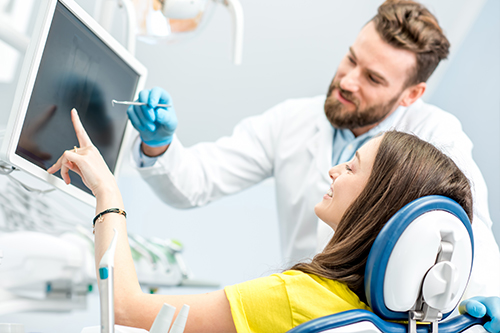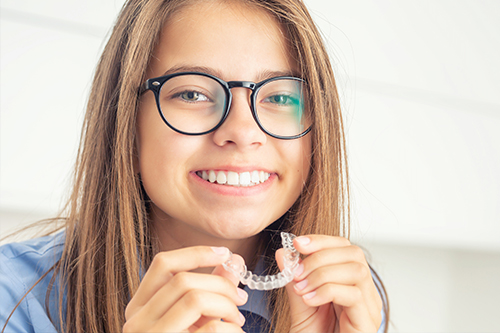
Invisalign® treatment has changed how many people approach orthodontic care: it combines advanced digital planning with removable, clear aligners that let you straighten your teeth without announcing the process to the world. For those who value discretion, comfort, and predictable results, clear-aligner therapy offers a modern alternative to traditional metal braces. Below you’ll find an in-depth look at how the system works, what to expect during treatment, and how our practice integrates this technology into patient care.
Clear-aligner therapy begins with a detailed digital scan of your mouth. That scan becomes a three-dimensional roadmap used to design a step-by-step plan showing how each tooth will move from its current position to the planned result. This level of visualization allows clinicians to anticipate the sequence of movements and plan for any attachments or refinements the case might require.
Each aligner in the series applies gentle, targeted pressure to specific teeth. As you progress from one aligner to the next, those small, controlled forces shift teeth incrementally. Because the movement is planned digitally in advance, the process tends to feel systematic and measurable — patients often notice gradual changes that are easy to track.
Clinician oversight remains essential. While the aligners do the daily work, your dentist monitors progress, makes adjustments as needed, and orders refinement trays when necessary. This collaborative approach between clinician and technology keeps treatment efficient and aligned with the intended outcome.
One of the most visible benefits of clear aligners is their aesthetics: the trays are made from transparent material designed to sit close to the teeth and remain inconspicuous during wear. For adults and image-conscious teens who prefer a low-profile option, this can be a compelling reason to pursue treatment.
Removability is another practical advantage. Aligners can be taken out for eating and for thorough oral hygiene, which simplifies brushing and flossing compared with fixed appliances. That freedom helps preserve gum health and lowers the risk of plaque accumulation around brackets and wires.
Comfort and convenience are also important considerations. The smooth plastic of aligners typically causes less soft-tissue irritation than metal components, and regular check-ins are often shorter and less frequent than traditional orthodontic visits. Combined with precise digital planning, these elements create a treatment experience that fits more easily into busy lives.
Your treatment begins with a consultation and a digital evaluation. During this visit, your clinician will assess your bite, review the scanned images, and outline a personalized plan that maps the desired tooth movements. Visual previews allow you to see a projected outcome before any work begins, which can help set realistic expectations.
Once the aligners are manufactured, you’ll receive a sequence to change on a regular schedule as directed by your clinician. Routine progress appointments are scheduled to ensure movement is tracking as planned and to manage any necessary refinements. If attachments or small auxiliaries are recommended, they are placed to enhance the ability of the aligners to perform specific types of movement.
Compliance plays a key role in success: consistent wear during the hours recommended by your clinician helps preserve the momentum of treatment. Should a tray feel uncomfortable initially, minor sensitivity is normal and usually subsides as your mouth adjusts. If concerns arise, your dental team will provide guidance and interventions to keep treatment on course.
At the end of active alignment, a retention phase is typically recommended to protect your results. Retainers help maintain the new tooth positions while supporting the tissues that adapt around them — retention is a long-term commitment that helps safeguard the investment of time and effort spent achieving your smile.
Good oral hygiene is straightforward with aligners, but it does require a consistent routine. Remove your trays to eat and brush and floss before reinserting them. Cleaning aligners regularly with recommended solutions or gentle brushing helps prevent staining and minimizes bacterial buildup. Avoid hot water, which can warp the plastic.
Dietary comfort is a practical benefit, since you can eat most foods by simply removing the aligners. Still, it’s wise to limit highly pigmented beverages while trays are in place and to maintain hydration to support oral comfort during long wear periods. Carrying a small oral-care kit when you are out can make it easier to handle meals and snacks without disrupting progress.
If you experience soreness after switching to a new tray, simple measures such as over-the-counter pain relievers and eating softer foods for a short time can help. Keep your clinician informed about persistent discomfort or any damage to the aligners so adjustments can be made without delay.
At the office of Suss Dental Group, clear-aligner therapy is delivered with an emphasis on individualized planning and ongoing clinical oversight. We integrate digital scanning and treatment-simulation tools into our workflow so patients see a thoughtful plan tailored to their dental anatomy and cosmetic goals. Technology enhances planning, but clinical judgment ensures the plan fits each patient’s unique needs.
We prioritize conservative, evidence-based approaches: aligner workflows are evaluated against functional and esthetic objectives to ensure that both bite function and smile appearance are addressed. Our team stays current with continuing education in orthodontic aligner therapy and collaborates to refine treatment protocols and deliver consistent care.
Communication is central to our process. From the initial consultation through the retention phase, we explain each step, answer questions, and provide clear guidance on wear schedules and maintenance. That transparency helps patients stay engaged and confident throughout their treatment.
For patients seeking an unobtrusive, contemporary path to a straighter smile, clear-aligner therapy offers well-documented benefits when delivered with appropriate clinical oversight. If you want to explore whether this option fits your goals, our practice can explain how Invisalign® integrates with your overall dental health plan.
As a leader in aligner development, Align Technology uses aggregated treatment data and research to refine aligner design and manufacturing. The combination of sophisticated materials and digital planning enables aligners to address a broad range of alignment and bite concerns with a high degree of control. This industry-wide data contributes to improvements in comfort, predictability, and the range of cases that can be treated effectively with clear aligners.
Custom-made to the specifications of each mouth, clear aligners are replaced on a prescribed cadence so the smile changes gradually and predictably. Because aligners are removable, they support better daily hygiene and allow you to maintain normal eating habits without compromising oral care. If you’d like a hands-on look at how aligners sit and function, we’re happy to demonstrate during a consultation.

Every case starts with an exam and a digital scan to establish a clear baseline. This information forms the foundation of a treatment plan that reflects both functional needs and esthetic goals.

Digital impressions replace traditional molds, offering faster, more accurate captures of your bite. The resulting simulation helps you and your clinician agree on the intended outcome before aligners are produced.

Aligners are produced using industry-standard materials engineered for a close fit and minimal irritation. When properly cared for, they remain clear and durable throughout each phase of treatment.

Regular checkups ensure movement is progressing as planned and that any necessary refinements are identified early. Your clinician is available to answer questions and help navigate any concerns along the way.
*Invisalign® is a registered trademark of Align Technology, Inc.
In summary, clear-aligner treatment combines modern digital planning with removable, near-invisible trays to deliver a discreet and controlled route to a straighter smile. When administered by an experienced dental team, this approach balances esthetic goals with functional care. If you’re considering Invisalign® or want to learn how it might fit into your dental plan, please contact us for more information.

There are many options for patients who want to avoid metal braces! The most popular alternative orthodontic treatment is Invisalign®, which are clear plastic aligners designed to straighten teeth. After an examination of your teeth, your dentist will determine which option is best suited to your wants and needs.
According to the Invisalign® website, the cost for treatment is approximately the same as the cost for metal braces. A portion of this cost may be covered by your insurance. Please call us to set up a consultation and discuss potential payment plan options.
The first step is to schedule a consultation with your doctor, so they can devise a treatment plan that is best suited to your individual dental needs. Once approved, you will receive your first set of aligners. Your doctor will then regularly monitor the movement of your teeth and new aligners will be ordered according to the progress made in your treatment plan.
Invisalign® aligners are made of clear, flexible plastic. The company received a patent for this material – SmartTrack® – to be used exclusively for Invisalign treatment purposes. These aligners are FDA approved and nearly invisible!
Your doctor will give you an estimate regarding how long your Invisalign® treatment should take, which will depend on your specific needs. The average length of time for treatment is approximately 12-18 months. However, some patients may see results far sooner. Remember to wear your aligners exactly as instructed by your doctor to obtain the best results.
Your doctor will most likely recommend that you wear retainers following your Invisalign® treatment. This is a precaution that will prevent your teeth from shifting back to their original positioning. It is important to follow your doctor's instructions exactly to ensure long-lasting results.
You must wear your aligners for up to 22 hours daily. You may remove them for eating, drinking and regular oral hygiene.
No. Unlike braces, you may eat whatever you like as long as you remove the aligners before eating. Prior to placing the aligners back on, it is important to brush your teeth and the aligners after you eat.
Like any orthodontic treatment, there is a short adjustment period. The more you speak with the aligners on, the quicker you will adjust.
There will be some pressure and minor discomfort for a day or two after each initial insertion. This is a sign that your teeth are moving sequentially into their final position.
It is recommended that you remove your aligners prior to chewing gum as the gum will stick to the aligners.
We discourage smoking with aligners as the cigarette smoke will tend to discolor them.
Brushing them with toothpaste will keep them fresh and clean.
Regular office visits are every five to six weeks. This will ensure that your Invisalign treatment is progressing as planned.
All orthodontic patients are instructed to wear their retainers at night indefinitely. Sleeping with your retainers in at night will ensure a healthy bite and maintain the new position of your teeth.
Yes, if their teeth, including second molars, have grown in completely.
Invisalign® is a clear-aligner system that straightens teeth using a series of custom-made, removable trays. Treatment begins with a detailed digital scan and a 3D treatment simulation that maps each step of tooth movement from start to finish. The digital plan helps both patient and clinician visualize the projected outcome before aligners are manufactured.
Each aligner applies gentle, targeted pressure to specific teeth so movements occur incrementally as you progress through the series. Aligners are changed on a prescribed schedule and clinician oversight ensures movements stay on track and refinements are made when necessary. This blend of digital planning and clinical management produces an efficient, measurable approach to orthodontic correction.
Many adults and adolescents with mild to moderate crowding, spacing, or bite concerns are excellent candidates for Invisalign®. Complex cases may still be treatable but can require additional auxiliaries, attachments, or combined approaches that your clinician will evaluate. Good oral health and a commitment to consistent wear are important prerequisites for predictable results.
Successful treatment depends on adherence to the prescribed wear schedule, regular progress visits, and maintaining healthy gums and teeth throughout therapy. Patients who are unwilling or unable to follow the wear recommendations may experience delays or suboptimal outcomes. Your clinician will review your history, current dental condition, and goals to determine if aligner therapy is the right option for you.
Treatment duration varies with the complexity of the case but often ranges from several months to around 18 months for many patients. Factors that influence timing include the severity of tooth movement required, how consistently aligners are worn, and whether refinements are needed during the course of therapy. Digital treatment planning provides a projected timeline, but that schedule can be adjusted based on real-world response.
Periodic progress appointments allow your clinician to confirm that movement is progressing as planned and to order additional aligners if minor adjustments are necessary. Compliance with wear instructions preserves the planned momentum and can shorten the active phase of treatment. After active alignment, a retention phase is typically recommended to maintain and protect the results.
Your initial visit includes a clinical exam, review of dental and medical history, and a digital scan or impressions to capture an accurate 3D model of your teeth. The scan is used to create a treatment simulation that shows a proposed sequence of movements and an estimated final alignment. During this visit your clinician will discuss goals, possible limitations, and whether attachments or other aids may be necessary.
The consultation is also an opportunity to review the expected timeline, ask questions about daily wear and care, and understand the retention plan at the end of active treatment. If you proceed, the digital prescription is submitted for aligner fabrication and a starting schedule is agreed upon. Clear communication at this stage helps set realistic expectations and promotes successful outcomes.
Proper care begins by removing aligners for eating and brushing and flossing your teeth before reinserting them to minimize staining and bacterial buildup. Clean aligners daily using the recommended cleaning solution or by gently brushing with a soft brush and cool water; avoid hot water, which can warp the plastic. Storing trays in their case when not in use prevents damage or loss and reduces contamination.
Maintaining routine dental checkups and professional cleanings throughout treatment helps protect gum health and detects any issues early. If an aligner becomes cracked, distorted, or uncomfortable, contact your dental team promptly so a replacement or adjustment can be arranged. Consistent hygiene and prompt attention to problems support both comfort and predictable progress.
Some patients notice a mild lisp or change in speech during the first few days as the mouth adjusts to the presence of aligners, but this typically resolves quickly with regular wear. Minor sensitivity or soreness is common during the first few days after switching to a new tray as teeth begin to move. These sensations are usually temporary and can be managed with over-the-counter pain relief and soft foods for a short period.
If you experience persistent or severe discomfort, difficulty speaking beyond the initial adjustment phase, or signs of soft-tissue irritation, contact your dental team for an evaluation. Adjustments to the fit, a review of wear patterns, or replacement of a damaged tray can often resolve problems. Ongoing communication with your clinician helps ensure comfort throughout treatment.
Attachments are small, tooth-colored composite bumps bonded to select teeth to provide aligners with additional grip and control for specific movements like rotation or extrusion. They act as handles that allow the aligner to apply forces more effectively and can be placed or removed by your clinician as treatment progresses. Attachments are discreet and designed to blend with the tooth surface while improving the predictability of certain movements.
Not every case requires attachments; their use depends on the planned biomechanics and the degree of movement needed. Your clinician will explain when attachments are recommended and how they will affect brushing, cleaning, and overall comfort. If refinements are needed later, attachments can be adjusted to support the new objectives.
Retention protects the new tooth positions after active alignment and is a critical part of long-term success. Your clinician will recommend a retainer type and a wear schedule tailored to your case, often including fuller-time wear initially followed by nightly use to preserve the results. Retainers can be removable or fixed, and the choice depends on functional needs and patient preferences.
Tissues surrounding the teeth, including bone and periodontal fibers, take time to adapt to their new positions, so ongoing retention helps prevent relapse. Regular follow-up appointments allow your clinician to monitor stability and make adjustments to retainers if needed. Proper cleaning and care of retainers prolong their effectiveness and hygiene.
Clinician oversight ensures that the digital treatment plan translates into safe, functional, and esthetic tooth movement for each individual patient. Regular progress checks allow the dental team to verify that movements align with the simulation, to identify any deviations early, and to request refinement trays or make chairside adjustments when necessary. Clinical judgment is essential to address occlusion, chewing function, and periodontal health alongside cosmetic goals.
At Suss Dental Group we combine advanced digital tools with evidence-based protocols and continuing education to refine treatment workflows and maintain consistent care. This collaborative approach between technology and clinical expertise improves predictability and helps patients achieve balanced, long-lasting results. Clear communication throughout the process supports compliance and timely intervention when adjustments are indicated.
To begin, schedule a consultation with our team in Bergenfield, NJ where a clinician will perform an exam, capture a digital scan, and discuss your smile goals and medical history. During this visit you will review the treatment simulation and receive a personalized plan outlining expected steps, potential attachments, and the retention strategy. The consultation is also a chance to ask detailed questions about daily wear, cleaning routines, and appointment scheduling.
If you decide to proceed, the digital prescription is submitted for aligner fabrication and a start date is arranged based on clinical readiness and logistics. Bringing recent dental records or x-rays can help streamline the evaluation, but your clinician will guide any needed imaging during the visit. Clear instructions and ongoing support from the dental team help patients progress confidently from consultation to finished results.

Ready to schedule your next dental appointment or have questions about our services?
Contacting Suss Dental Group is easy! Our friendly staff is available to assist you with scheduling appointments, answering inquiries about treatment options, and addressing any concerns you may have. Whether you prefer to give us a call, send us an email, or fill out our convenient online contact form, we're here to help. Don't wait to take the first step towards achieving the smile of your dreams – reach out to us today and discover the difference personalized dental care can make.